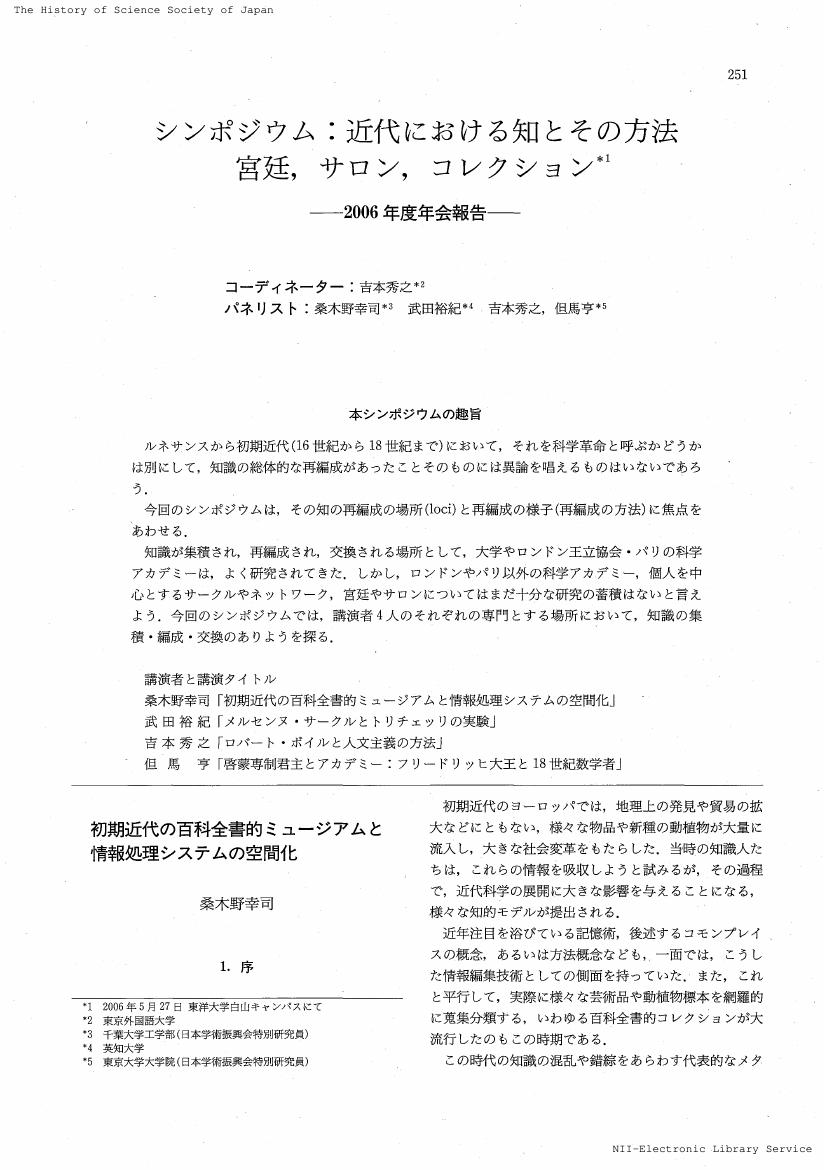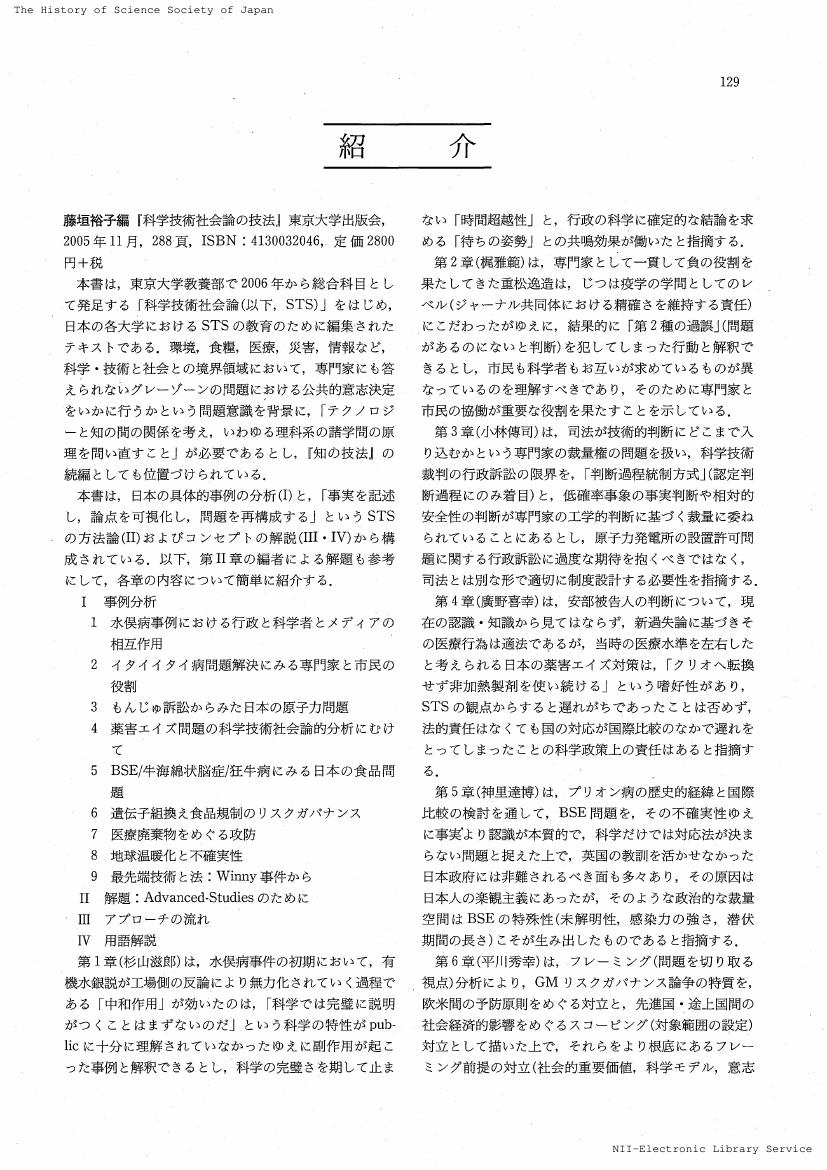1 0 0 0 OA 第53回日本科学史学会年会・総会報告
- 出版者
- 日本科学史学会
- 雑誌
- 科学史研究 (ISSN:21887535)
- 巻号頁・発行日
- vol.45, no.240, pp.245-250, 2006 (Released:2021-08-11)
1 0 0 0 OA シンポジウム:近代における知とその方法宮廷,サロン,コレクション-2006年度年会報告-
1 0 0 0 OA 第22回国際科学史会議での日本からの報告(続々)
1 0 0 0 OA 知的財産権と技術発展(科学史入門)
- 著者
- 名和 小太郎
- 出版者
- 日本科学史学会
- 雑誌
- 科学史研究 (ISSN:21887535)
- 巻号頁・発行日
- vol.45, no.240, pp.241-244, 2006 (Released:2021-08-11)
1 0 0 0 OA 1890年代の熱輻射分布法則導出におけるパッシェンの実験研究の先導的役割
- 著者
- 小長谷 大介
- 出版者
- 日本科学史学会
- 雑誌
- 科学史研究 (ISSN:21887535)
- 巻号頁・発行日
- vol.45, no.240, pp.229-240, 2006 (Released:2021-08-11)
This paper examines the process and development of revolutionary data of thermal radiation in the late 19th century, focusing on Friedrich Paschen's experimental research in the early to mid-1890s. The well-known experiments of O. Lummer and E. Pringsheim, H. Rubens and F. Kurlbaum had brought about the suggestive results concerning Planck's radiation law. Paschen's research played an important role in pioneering experimentalists who were active in the early 1890s. Before Lummer, Pringsheim, Rubens, and Kurlbaum made a series of experiments on the radiation law, Paschen had begun to research on the "Normal Spectrum " representing the spectral distribution of radiation energy. He had made it to examine the spectrum of diffraction grating with the directions of H. Kayser in 1891-1892. In the meantime, other experimentalists such as Lummer and Rubens conducted research on the measurements of luminous intensity and electricity at the request of refining the standards. In 1893 Paschen improved the foundation for experiments on thermal radiation by utilizing those different kinds of measurements and made a step forward in the precision measurements of radiation distribution function.
1 0 0 0 OA 紹介
- 出版者
- 日本科学史学会
- 雑誌
- 科学史研究 (ISSN:21887535)
- 巻号頁・発行日
- vol.45, no.239, pp.204-205, 2006 (Released:2021-08-11)
1 0 0 0 OA 戸坂潤の『全集』未収録文献22編の発見(アゴラ)
- 著者
- 北林 雅洋
- 出版者
- 日本科学史学会
- 雑誌
- 科学史研究 (ISSN:21887535)
- 巻号頁・発行日
- vol.45, no.239, pp.189-190, 2006 (Released:2021-08-11)
1 0 0 0 OA オイラーの変分力学
- 著者
- 有賀 暢迪
- 出版者
- 日本科学史学会
- 雑誌
- 科学史研究 (ISSN:21887535)
- 巻号頁・発行日
- vol.45, no.240, pp.220-228, 2006 (Released:2021-08-11)
Although newtonian mechanics is the most familiar formulation of classical mechanics, we have an another one called variational mechanics. Leonhard Euler attempted to solve some mechanical problems using the latter idea and gave two variational-mechanical laws : "law of rest " in statics, and "law of motion " in dynamics. He maintained that these two laws were "in harmony ", namely that the one could be derived from the other. Moreover, they are both based on "principle of least action, " according to which some quantities are minimum in physical phenomena. In effect, "law of rest " asserts that the sum of "efforts " for bodies is minimum in equilibrium, which Euler interprets as the evidence of the intention of nature to "save efforts. " "Law of motion " determines the trajectory of a mass point, in which "action " is minimum; according to Euler, this could be explained by the inertia of bodies. These laws show Euler's faith in his principle, even though he doesn't use the condition of "minimum " in solving concrete problems; therefore, his "principle of least action " is not a mathmatical requirement. His demonstration of the "harmony " is also based on the belief that nature "saves efforts. " This attempt is, however, a failure in a double meaning; we can't prove the "harmony " from the point of modern view, and Euler's proof is inconsistent with his own "principle of least action. " "Euler's variational mechanics " has failed to realize a unified treatment of statics and dynamics, because it was built up on the "principle of least action. "
1 0 0 0 OA 経済学における技術の諸理論と環境問題の分析に関する一試論
- 著者
- 氏川 憲次
- 出版者
- 日本科学史学会
- 雑誌
- 科学史研究 (ISSN:21887535)
- 巻号頁・発行日
- vol.45, no.239, pp.162-165, 2006 (Released:2021-08-11)
1 0 0 0 OA 日本の近代化と物理実験機器(科学史入門)
- 著者
- 永平 幸雄
- 出版者
- 日本科学史学会
- 雑誌
- 科学史研究 (ISSN:21887535)
- 巻号頁・発行日
- vol.45, no.238, pp.99-102, 2006 (Released:2021-08-11)
- 著者
- 荒尾 美代
- 出版者
- 日本科学史学会
- 雑誌
- 科学史研究 (ISSN:21887535)
- 巻号頁・発行日
- vol.45, no.239, pp.157-161, 2006 (Released:2021-08-11)
1 0 0 0 OA 紹介
- 出版者
- 日本科学史学会
- 雑誌
- 科学史研究 (ISSN:21887535)
- 巻号頁・発行日
- vol.45, no.238, pp.129, 2006 (Released:2021-08-11)
1 0 0 0 OA 第22回国際科学史会議での日本からの報告(続)
1 0 0 0 OA 絶縁ゲート型電界効果トランジスタ研究について(日本科学史学会第53回年会記念講演)
- 著者
- 菅野 卓雄
- 出版者
- 日本科学史学会
- 雑誌
- 科学史研究 (ISSN:21887535)
- 巻号頁・発行日
- vol.45, no.239, pp.166-172, 2006 (Released:2021-08-11)
1 0 0 0 OA 技術の内的発展法則論と歴史の法則性(アゴラ)
- 著者
- 山崎 正勝
- 出版者
- 日本科学史学会
- 雑誌
- 科学史研究 (ISSN:21887535)
- 巻号頁・発行日
- vol.45, no.238, pp.103-104, 2006 (Released:2021-08-11)
1 0 0 0 OA ソヴィエトの語法を身につけた物理学者 : 1930年代哲学論争とその帰結
- 著者
- 金山 浩司
- 出版者
- 日本科学史学会
- 雑誌
- 科学史研究 (ISSN:21887535)
- 巻号頁・発行日
- vol.45, no.239, pp.145-156, 2006 (Released:2021-08-11)
In this paper, I examine the reason for the subsidence of Soviet dispute over philosophical legitimation of modern physics in the late 1930s. The battle of scientists against party ideologues or their sympathizers was politically adventurous in the period of the Great Terror. In fact, established scientists such as Nikolai Vavilov were severely accused by opponents and were led even to be imprisoned. However, in spite of the heated attack to some leading physicists in the dispute over modern physics in philosophical journals, the worst tragedy was avoided in general. I maintain that Sergei Vavilov, one of the most influential physicists of this period, acted as a crucial negotiator in this process. By learning the Marxist terminology or a politically correct attitude in the discourse, Vavilov succeeded in soothing the party ideologues and at the same time guarding modern physics or physicists. In some respect he made a compromise, but it was a very valuable one.
1 0 0 0 OA ロックフェラー財団による184インチのサイクロトロン計画への援助決定過程
- 著者
- 日野川 静枝
- 出版者
- 日本科学史学会
- 雑誌
- 科学史研究 (ISSN:21887535)
- 巻号頁・発行日
- vol.45, no.238, pp.81-91, 2006 (Released:2021-08-11)
The World War II broke out in Europe in 1939, and the United States set up the National Defense Research Committee on June in 1940. On April 3,1940, the Meeting of Trustees of the Rockefeller Foundation decided on a grant of $1,150,000 to support the construction of a new 184-inch cyclotron at the University of California. This paper elucidates the process leading up to that decision. The decision-making process can be divided into three stages : The first, beginning in October 1939, saw initial enthusiasm for the giant cyclotron project; the second, lasting until February 1940, involved changes in the Foundation's internal circumstances and limitations on funding; the third, which began in early February 1940, saw specific steps toward the materialization of Foundation support for the project. Doubtlessly, Lawrence's supporters tangibly and intangibly influenced the Rockefeller Foundation's decision to support the construction of the giant cyclotron. The decision-making process, however, seems to shed light on the Foundation's grant-making plans or grant-making policy. That is, the Foundation was deeply involved in drawing up the plans from the start, and provided grants for carefully-selected, large-scale, and long-range projects in the fields it was interested in. The giant cyclotron project, for which single-source support was an important issue, seems to be one such case.
1 0 0 0 OA 梅文鼎著『中西算學通』と清華大学図書館の暦算書
- 著者
- 小林 龍彦
- 出版者
- 日本科学史学会
- 雑誌
- 科学史研究 (ISSN:21887535)
- 巻号頁・発行日
- vol.45, no.238, pp.92-95, 2006 (Released:2021-08-11)
1 0 0 0 OA 来日学者の講演と開会式から見た1953年国際理論物理学会・京都&東京(アゴラ)
- 著者
- 溝畑 典宏
- 出版者
- 日本科学史学会
- 雑誌
- 科学史研究 (ISSN:21887535)
- 巻号頁・発行日
- vol.45, no.237, pp.70-72, 2006 (Released:2021-08-11)
- 被引用文献数
- 1















